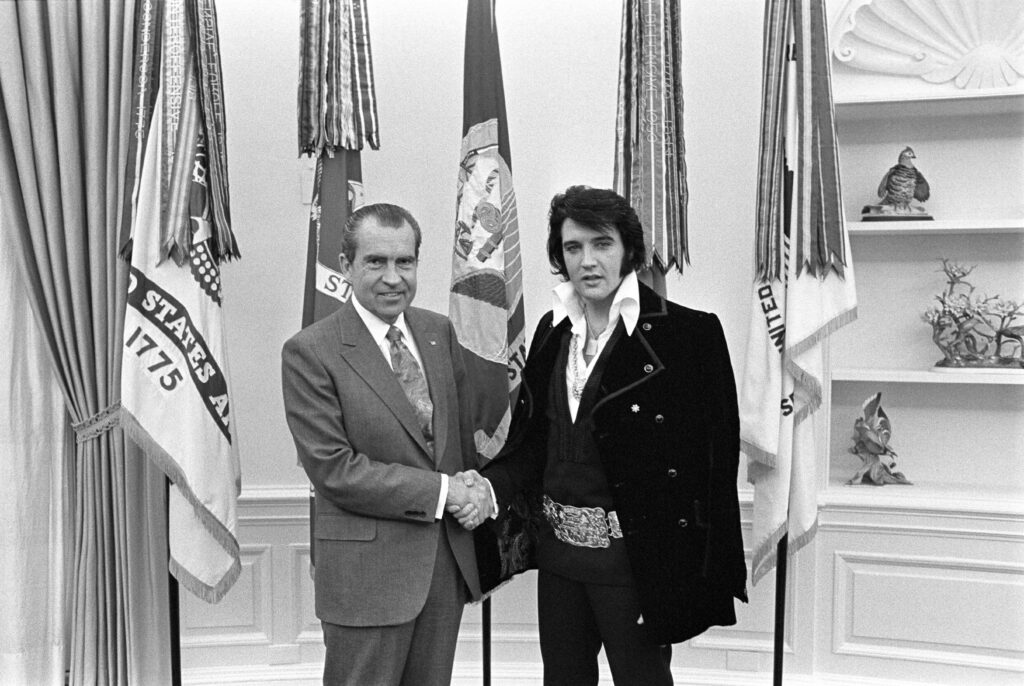50 years ago today, on December 21, 1970, the president of the United States, Richard Nixon, met with one of the greatest singers of all time, Elvis Presley, at the White House.

The story goes that Elvis requested the meeting with Nixon, as he wanted the president to appoint him a “federal agent at large” in what was then known as the “Bureau of Narcotics and Dangerous Drugs”. (BNDD merged into the DEA in 1973.) Elvis believed he could be a force for good and fight drug use among the young people.
Smithsonian magazine has a slightly different version of the story (written by the great Peter Carlson):
The story began in Memphis a few days earlier, when Elvis’ father, Vernon, and wife, Priscilla, complained that he’d spent too much on Christmas presents—more than $100,000 for 32 handguns and ten Mercedes-Benzes. Peeved, Elvis drove to the airport and caught the next available flight, which happened to be bound for Washington. He checked into a hotel, then got bored and decided to fly to Los Angeles.
…
Elvis was traveling with some guns and his collection of police badges, and he decided that what he really wanted was a badge from the federal Bureau of Narcotics and Dangerous Drugs back in Washington. “The narc badge represented some kind of ultimate power to him,” Priscilla Presley would write in her memoir, Elvis and Me. “With the federal narcotics badge, he [believed he] could legally enter any country both wearing guns and carrying any drugs he wished.”
Anyway, Elvis wrote a letter to Nixon (reproduced here, transcription here) asking for the position and a badge. There was some internal discussion at the White House, but presidential aide Egil “Bud” Krogh persuaded Nixon to agree to the meeting.
That personal gift Elvis mentions in his letter? It was a Colt .45. I have seen it asserted both that the Secret Service confiscated it before Elvis got in to see Nixon, and that Elvis got it past the guards and personally presented it to Nixon.
Nixon’s famous taping system had not yet been installed, so the conversation wasn’t recorded. But Krogh took notes: “Presley indicated that he thought the Beatles had been a real force for anti-American spirit. The President then indicated that those who use drugs are also those in the vanguard of anti-American protest.”
“I’m on your side,” Elvis told Nixon, adding that he’d been studying the drug culture and Communist brainwashing.
Elvis asked for a BNDD badge, and Nixon basically said “Make it so.”
Before leaving, Elvis asked Nixon to say hello to Schilling and West, and the two men were escorted into the Oval Office. Nixon playfully punched Schilling on the shoulder and gave both men White House cuff links.
“Mr. President, they have wives, too,” Elvis said. So Nixon gave them each a White House brooch.
After Krogh took him to lunch at the White House mess, Elvis received his gift—the narc badge.
The meeting was kept secret at the time: Jack Anderson covered it a year later, but apparently nobody actually gave a tinker’s damn back then.
Today:
Of all the requests made each year to the National Archives for reproductions of photographs and documents, one item has been requested more than any other. That item, more requested than the Bill of Rights or even the Constitution of the United States, is the photograph of Elvis Presley and Richard M. Nixon shaking hands on the occasion of Presley’s visit to the White House.
You can download copies of the photos from the George Washington University National Security Archive (their site has been a major help in writing this). NARA has a site devoted to the meeting, but it is annoying as all get out. You can order a print here, as well as some other related merchandise.
“Bud” Krogh apparently wrote a book about the meeting (called, fittingly, The Day Elvis Met Nixon (affiliate link)) which I believe is out of print but readily available from Amazon.
